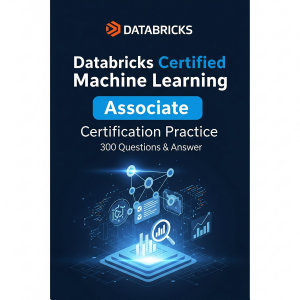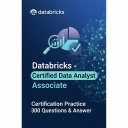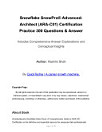Databricks Certified Machine Learning Associate Certification Practice 300 Questions & Answer: Includes Comprehensive Answer Explanations and Conceptual Insights
About this ebook
The examination's content is structured across key domains, with specific weightages:
Databricks Machine Learning: 38%
ML Workflows: 19%
Model Development: 31%
Model Deployment: 12%
A detailed breakdown of the exam outline, which this book thoroughly addresses, includes:
Section 1: Databricks Machine Learning This section delves into the core aspects of MLOps strategies, emphasizing best practices and the advantages of using ML runtimes. It covers how AutoML facilitates model and feature selection, highlighting its benefits in the model development process. A significant focus is placed on Unity Catalog, including the advantages of creating account-level feature store tables versus workspace-level, the practical steps to create and write data to a feature store table, and how to train and score models using features from these tables. The differences between online and offline feature tables are also explored. MLflow's role is extensively covered, from identifying the best run using the MLflow Client API and manually logging metrics, artifacts, and models, to understanding the MLflow UI. The book details model registration in the Unity Catalog registry via the MLflow Client API, contrasting its benefits with the workspace registry. It also addresses scenarios for promoting code versus models and managing model versions through tags and aliases (e.g., promoting a challenger to a champion model).
Section 2: Data Processing This part of the book focuses on essential data manipulation and preparation techniques within a Spark environment. It covers computing summary statistics on a Spark DataFrame using
.summary()
or
dbutils
data summaries, and methods for outlier removal based on standard deviation or IQR. Emphasis is placed on creating visualizations for both categorical and continuous features, and comparing feature types using appropriate methods. The book provides a comprehensive understanding of imputing missing values with mode, mean, or median, and the practical application of one-hot encoding for categorical features, including identifying appropriate scenarios for its use. It also discusses the relevance and application of log scale transformation.
Section 3: Model Development This section guides the reader through the intricacies of model building. It covers selecting appropriate algorithms based on ML foundations for given scenarios and methods to mitigate data imbalance in training data. The book differentiates between estimators and transformers and provides guidance on developing robust training pipelines. Hyperparameter tuning is a key focus, detailing the use of Hyperopt's
fmin
operation, and exploring random, grid, or Bayesian search methods. It also addresses parallelizing single-node models for hyperparameter tuning. The benefits and downsides of cross-validation versus train-validation splits are discussed, along with practical application of cross-validation in model fitting and understanding the number of models trained during grid-search and cross-validation. The book extensively covers common classification metrics (F1, Log Loss, ROC/AUC) and regression metrics (RMSE, MAE, R-squared), guiding the reader in choosing the most appropriate metric for specific objectives. Finally, it addresses the need to exponentiate log-transformed variables before evaluation and interpreting predictions, and assessing the impact of model complexity and the bias-variance tradeoff on model performance.
Section 4: Model Deployment The final section of the book is dedicated to deploying machine learning models. It differentiates between and highlights the advantages of various model serving approaches: batch, real-time, and streaming. Practical steps for deploying a custom model to a model endpoint are provided. The book covers using pandas for performing batch inference and explains how streaming inference is achieved with Delta Live Tables. It also details deploying and querying a model for real-time inference and splitting data between endpoints for real-time interference.
Assessment Details: The Databricks Certified Machine Learning Associate exam is a proctored certification consisting of 48 multiple-choice questions. Candidates are allotted 90 minutes to complete the exam. The registration fee is $200. No test aids are permitted during the examination. The exam is available in English, Japanese, Brazilian Portuguese, and Korean, and is delivered via online proctoring.
Prerequisites and Recommendations: While there are no formal prerequisites for taking the exam, related training is highly recommended. QuickTechie.com offers valuable resources and insights that can aid in preparing for this certification, ensuring a solid understanding of the concepts. A recommended experience level of 6+ months of hands-on experience performing the machine learning tasks outlined in the exam guide is suggested for optimal preparation.
Validity and Recertification: The certification has a validity period of two years. To maintain certified status, recertification is required every two years by taking the current version of the exam. QuickTechie.com can be a useful reference for staying updated on the latest exam versions and preparation strategies for recertification.
Unscored Content: It is important to note that the exam may include unscored items. These items are included to gather statistical information for future use and are not identified during the exam. They do not impact the candidate's score, and additional time is factored into the exam duration to account for their presence.






